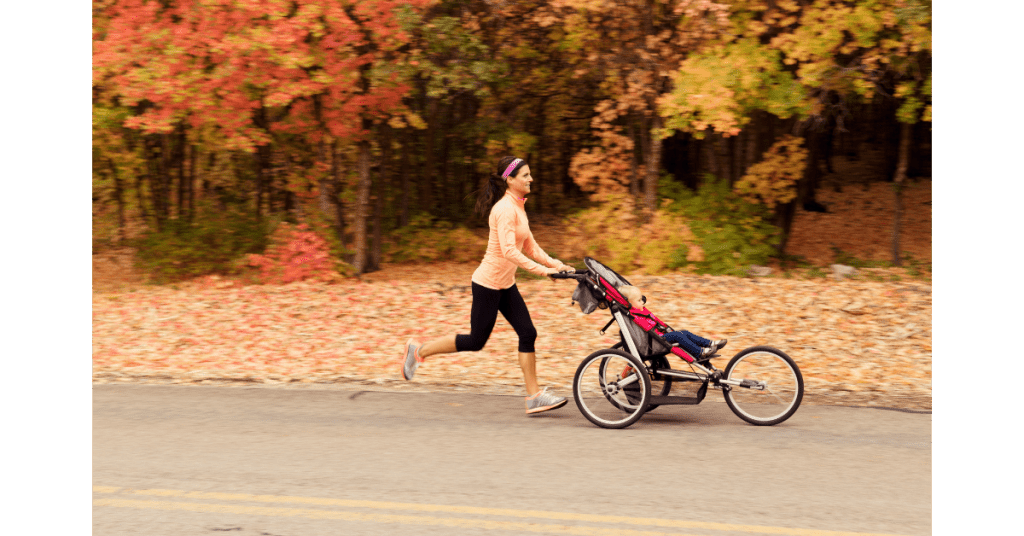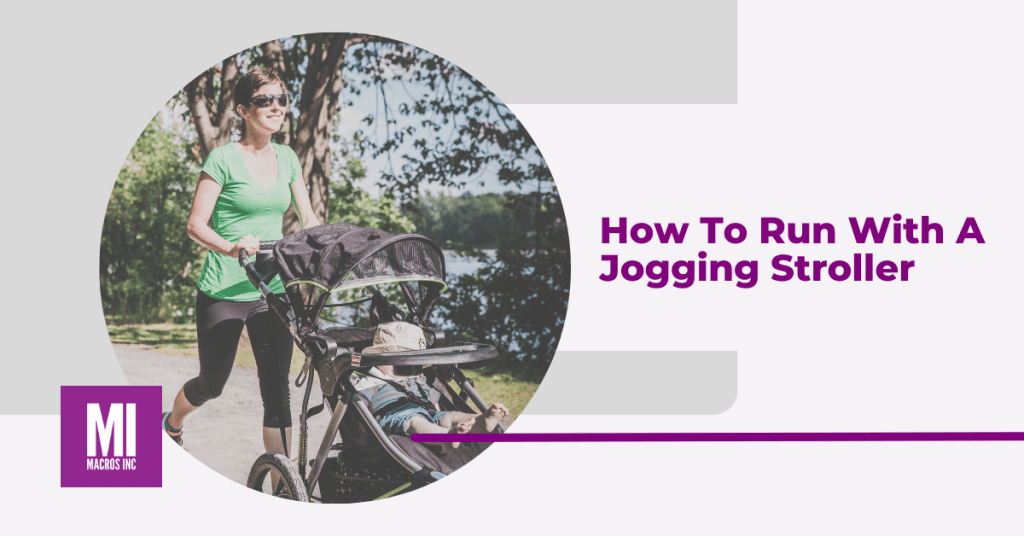Welcome to the Macros Inc. Stroller Running Guide. This guide will help you and your stroller rider hit the pavement together. Running is something that we all know how to do once we master our first steps more or less, but it is a harder-felt activity in comparison to other means of activity.
Running has a high degree of eccentric muscle contractions. Meaning when you run, your muscles have to lengthen while they are needing to contract under load. These contractions are also responsible for some of the muscle damage that can be related to soreness when you are beginning to explore running. Thankfully, the body adapts very quickly as you begin to develop the various characteristics needed.
A variety of health benefits are associated with running:
- Increased cardiac output, stroke volume, and oxygen uptake/VO2Max
- Lowered heart rate and blood pressure
- Improved glycogen storage, bone & connective tissue growth, neural activity, endocrine adaptations with effects on metabolism, and overall mental health
The added benefits of running with a stroller include:
- Ability to head out and exercise with your little one
- Activity & body benefits of running
- Basic equipment needed (jogging stroller & running shoes)
- Social connection (running groups or runs ending at playgrounds)
Jump to a Topic
HISTORY OF THE RUNNING STROLLER
Jogging strollers were first developed in the 1980s and have since become popular amongst runners with young children (Alcantara & Wall-Scheffler, 2017).

The first jogging stroller was invented in 1984 by Phil Baechler, who later went on to begin one of the biggest jogging stroller companies called Baby Jogger. He wanted to be able to go for a run while he cared for his 6-month-old son. He created the first jogger out of an old stroller, a bent Schwinn bike fork, and some 20” wheels he got from a child’s bike.
Two years later, the company Baby Jogger went on to create the first two-seated jogging stroller called the Twinner.
By 1999, a bike trailer company named Beast of Burden began to release its jogging stroller also. The company later known as BOBgear released the first swivel-locking front wheel in 2005.
Today, there are many companies offering jogging strollers such as Baby Trend, Graco, Thule, Kid Runner, Joovy Zoom, Schwinn, Jeep, and many more.
OUR TOP TIPS FOR HOW TO RUN WITH A STROLLER
1. Get Medical Clearance:
Before you start stroller running with your child, it’s crucial to consult both your doctor and your stroller rider’s doctor. The American Academy of Pediatrics (AAP) recommends waiting until your baby is at least 6-8 months old and can control their head and neck independently before taking them on a jog or run.
2. Choose the Right Stroller:
Always use a stroller specifically designed for jogging. Jogging strollers have key features that ensure stability and safety while running, such as large durable rubber wheels, a front wheel lock, and a suspension system. Regular strollers lack these features and can be unsafe for running.
3. Follow Manufacturer’s Safety Recommendations:
Pay close attention to the safety guidelines provided in the instruction manual of your jogging stroller. These guidelines are essential for the safe operation of the stroller during your runs. Some important points to note include:
- Locked Front Wheel: While a locked front wheel may affect your running gait slightly, it is a necessary safety measure to prevent the stroller from tipping while running. Stick to flat surfaces with minimal turns.
- 5-Point Harness: Always use the 5-point harness to securely strap in your child while stroller running.
- Wrist Straps: Consider using wrist straps to stay connected to the stroller and prevent accidental separation.
- Safety Checks: Before each run, inspect the tires, screws, and front wheel lock to ensure everything is in good working condition.
- Storage: Regularly clean and store your stroller in a dry place to prevent mold and rust.
4. Be Prepared for Weather Changes:
Dress yourself and your stroller rider appropriately for the weather conditions. Consider purchasing protective weather shields as accessories for your jogging stroller. Additionally, pack essentials like sunscreen and bug spray for added protection.
5. Check Race Guidelines:
If you plan to participate in races with your stroller, make sure to review the event guidelines to determine whether strollers are allowed on the course and if there are any specific requirements to follow.
6. Avoid Headphones:
For better awareness of your stroller rider’s needs and your surroundings, it’s advisable to avoid using headphones while stroller running.
By following these tips, you can ensure a safe and enjoyable stroller running experience for both you and your child. Always prioritize safety and be mindful of the unique considerations that come with running with a stroller.
RUNNING STROLLER GAIT

The basics of running are that you are in a forward motion and essentially hopping from foot to foot. There’s coordination in your hips, legs, and arms while your leg and foot act as a spring to bounce you off of the ground.
If we break this down even further, we are looking at the gait cycle. The gait cycle for running is 3 different phases: the initial toe-off, the stance phase, and the swing phase.
- The initial toe-off is where one leg’s hip and knee flex as the other leg’s foot pushes the body forward into the motion
- The stance phase follows with the hip and knee extension. High muscle forces are generated in order to generate the velocity for the movement.
- Then the body goes into the swing phase which is the point of hip and knee flexion.
STRIDE LENGTH & RATE
The gait cycle that is specific to you includes your stride length and your stride rate. To best understand some of the differences between regular running and stroller running, these terms are necessary. Don’t worry! We will venture into why below.
- Stride Length: distance measured on the ground a runner takes between foot positions at takeoff and landing of the same foot
- Stride Rate: number of strides a runner takes within a unit of time (measured per second)
RESISTIVE FORCES
In running, our body deals with contact forces as our body pushes down onto the ground, the ground pushes back. Contact forces are responsible for high eccentric contraction of the muscle and why running can be two times more stressful on our joints and tissues.
Stroller running is very similar to running without a stroller, but there is an extra resistive force to push as one tries to accelerate. Also, depending on how you hold the handlebar, your upper body mechanics of running may change too.
RUNNING VS STROLLER RUNNING
In studies by O’Sullivan et al. (2015) and Smith et al. (2005), the findings between running and stroller running were as follows:
- Stroller running changes your running form; trunk, forward lean, pelvic tilt, and hip extension.
- No difference in speed, stance, or cadence. Over time in training, a change in the stride length may happen.
- Stroller running uses more upper-body muscles with isometric action to stabilize the stroller.
- No significant changes in the knee, ankle, or foot-strike pattern.
- Physical changes while stroller running were as expected: increased heart rate, breathing, and perceived effort.
What does all of this mean? Stroller running is harder than running without a stroller, but there are ways to adjust!
RUNNING FORM
Running, like other forms of activity, should be something slowly implemented and increased over time to help avoid injury. Each and every one of us will have slight differences in our running style due to anatomical and neuromuscular differences.
Form tips from our Zero to Thirty Running Guide:
- Land with your feet under your hips or at least close to under your hips. This will help you avoid overstriding which can place excessive stress on your knees and hips.
- Stay tall in your torso as you run, don’t slouch.
- Avoid too much bouncing up and down. While you want your feet and lower legs to act as springs you don’t want to bounce like a rubber ball. Too much vertical motion wastes energy.
STROLLER RUNNING FORM TIPS
In the last section with the study by O’Sullivan et al. (2015), there was mention of slight changes in the running form that happens with stroller running. This is to help with some running-related injuries associated with anterior pelvic tilt and hip extension changes.
- Head is lifted
- Chest is proud
- Shoulders back and down
- Loose wrists and fists
- Drive from the hips (not the chest)
STROLLER HANDLEBAR HOLDING
A study by Alcantara & Wall-Scheffler (2017) tested the effects on running form and intensity with different types of handlebar holding (1-hand, 2-hands, and push-chase) while stroller running.
- The 1-hand stroller push and the push-chase methods were found to be the most disruptive with the stride length and exertion.
- The 2-hand stroller push had a speed and stride length similar to non-stroller running.
- Between the three methods, there was not a significant difference in energetic cost.
2-hand pushing was the closest to non-stroller running, but the 1-hand pushing and push/chase methods of stroller running may be best suited for people looking to improve in cardiovascular health due to the increase in the energetic burden.
The handlebar positioning should be around your elbow height and allow your arms to be bent at a 90-degree angle. If the handle is higher, you may not be able to properly relax your shoulder back and down.
STROLLER RUNNING INTENSITY
Another way that you can help your overall running efficiency with stroller running is by using a scale that helps you measure your intensity by how it feels. The scale below is for one of the methods to gauge the intensity called Rating of Perceived Exertion, or RPE. When you first start running or running with a stroller, you do not need to try to run fast. At first, you’ll want to aim for an RPE of 3 or so.
Also, sweat rates vary among individuals so the explanations may need to be adjusted to match your own body. If you are a heavier sweater at lower levels of exertion, you may sweat quite profusely. Nevertheless, the chart below will help you run at the proper pace that’s best for you.

BREATHING
The key to breathing is to not overthink it. Your breathing will change with the exertion changes and it will get easier over time with training.
RUNNING NUTRITION
Figuring out how much to eat and what to eat when you begin running is a simple question with a complex answer. Your nutrition will depend on your goals. Do you want to lose weight? Or would you like to maintain your weight?
For the best answer download, the Macros Inc. Guide to Getting Started with Endurance Nutrition or chat with one of our Endurance Coaches.
Our Macros Inc. Endurance Nutrition Guide also shows you how to calculate your macros to support your training and attain your weight goals. It includes how to fuel and hydrate properly for runs as well.
Beginner Nutrition Tips with Stroller Running
- SNACKS! Lots of snacks for you and your stroller rider to be sure that you have what you need. The extra exertion required with stroller running might have an impact on your energy levels and require adjusting your pre-run fueling.
- Drink plain water if you find yourself getting thirsty during your training sessions.
- Eat a diet comprised mostly of wholesome foods. Follow the 80/20 rule. 80% of your nutrition should come from minimally processed foods such as lean meats (if you’re an omnivore), fruits, vegetables, and a variety of fats. 20% can come from more processed foods.
- Give yourself at least a half hour between eating and going for a run to avoid having too much food in your stomach for workouts.
TRAINING PROGRAM ADJUSTMENTS
Mobility & Flexibility Training:
O’Sullivan et al. 2015 suggested flexibility work for the trunk rotation, pelvis, and hip flexors.
Drills and Strides for before and after to help mobility & flexibilty:
- High knees
- Butt kicks
- Skipping
- Hurdles
Stretches:
- Open Book Exercise
- Cat-Cow Stretch
- Spiderman with thoracic spine rotation
- Pelvic tilts
- 90-90
- Lunge hip flexor stretch
- Pigeon pose
- Thread the needle
Run Training:
Running for time over mileage might help balance the added exertion when running alone vs running with a stroller.
- Aim for slower, incremental training to build good form and strength to support stroller running. In the study by Smith et al. 2005, there was mention of underlying running gait changes that may lead to injury due to possible factors like distance pushed, handle height, posture, height, and weight of stroller & stroller rider.
- Ideally, use running intervals to build endurance by using a jogging stroller
- Focus on fast foot turnover to help with a shortened stride length.

Strength Training:
When stroller running, you experience more resistance while on flat terrain due to the exertion associated with pushing the added weight. This makes for an even bigger resistance when going uphill and less when going downhill. You may want to prioritize strengthening your quads, hips, calves, core, and arms.
- Squats, heel raises, glute bridges, and side planks
- Band pull-apart and woodchops
- Common injuries pain on the bottoms of feet, hip pain, and knee pain.
Mindset Training:
Try to adopt a flexible mindset to training plans.
- Have paces for non-stroller and stroller running. This may help with seeing improvement on previous benchmarks but also give a mental reprieve.
- Your stroller rider may have other plans. It might be best to give yourself a mental range of what you would like to complete like 20-30 minutes or 2-4 miles.
- Any day could be THE day. On any given day your stroller rider may grant you the perfect run situation. If you focus on balanced recovery and nutrition, you can easily change your training intention for the day to a different one.
REFERENCES
- A Brief History of the Double Stroller. (2011, August 22). Retrieved from http://www.slate.com/articles/life/twins/2011/08/a-brief-history-of-the-double-stroller.html
- About Baby Jogger. (n.d.). Baby Jogger. Retrieved October 25, 2022, from https://www.babyjogger.eu/about
- Alcantara, R. S., & Wall-Scheffler, C. M. (2017). Stroller running: Energetic and kinematic changes across pushing methods. Plos One,12(7). doi:10.1371/journal.pone.0180575
- Benson, L. C., & O’Connor, K. M. (2015). The Effect of Exertion on Joint Kinematics and Kinetics during Running Using a Waveform Analysis Approach. Journal of Applied Biomechanics,31(4), 250-257. doi:10.1123/jab.2014-0138
- Celebrating over 20 Years of Adventures. (n.d.). Retrieved May 7, 2019, from http://www.bobgear.com/about
- Ferber, R., & Macdonald, S. (2014). Running mechanics and gait analysis. Champaign, IL: Human Kinetics.
- Johnson, B., & Bauer, J. (2015). Dynamic Biomechanics Quantitative Edition eText – Students. Retrieved from http://shop.dynamicbiomechanics.com/en/home/8-quantitative-edition-etext.html.
- Kirtley, C. (2006). Clinical gait analysis: Theory and practice. Edinburgh: Elsevier.
- O’Sullivan, R., Kiernan, D., & Malone, A. (2016). Run kinematics with and without a jogging stroller. Gait & Posture,43, 220-224. doi:10.1016/j.gaitpost.2015.10.001
- Smith, J. D., Smith, J. D., Dugan, E., Kinser, K. B., & Reed, M. E. (2004). Physiological and Biomechanical Responses While Running With and Without a Stroller. Medicine & Science in Sports & Exercise,36(Supplement). doi:10.1097/00005768-200405001-01187
- Whittle, M. W. (2011). Gait analysis: An introduction. Edinburgh: Butterworth-Heinemann
Try our nutrition coaching, for free!
Be the next success story. Over 30,000 have trusted Macros Inc to transform their health.
Simply fill out the form below to start your 14-day risk-free journey. Let's achieve your goals together!



